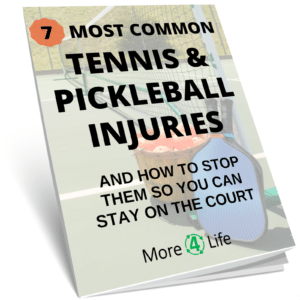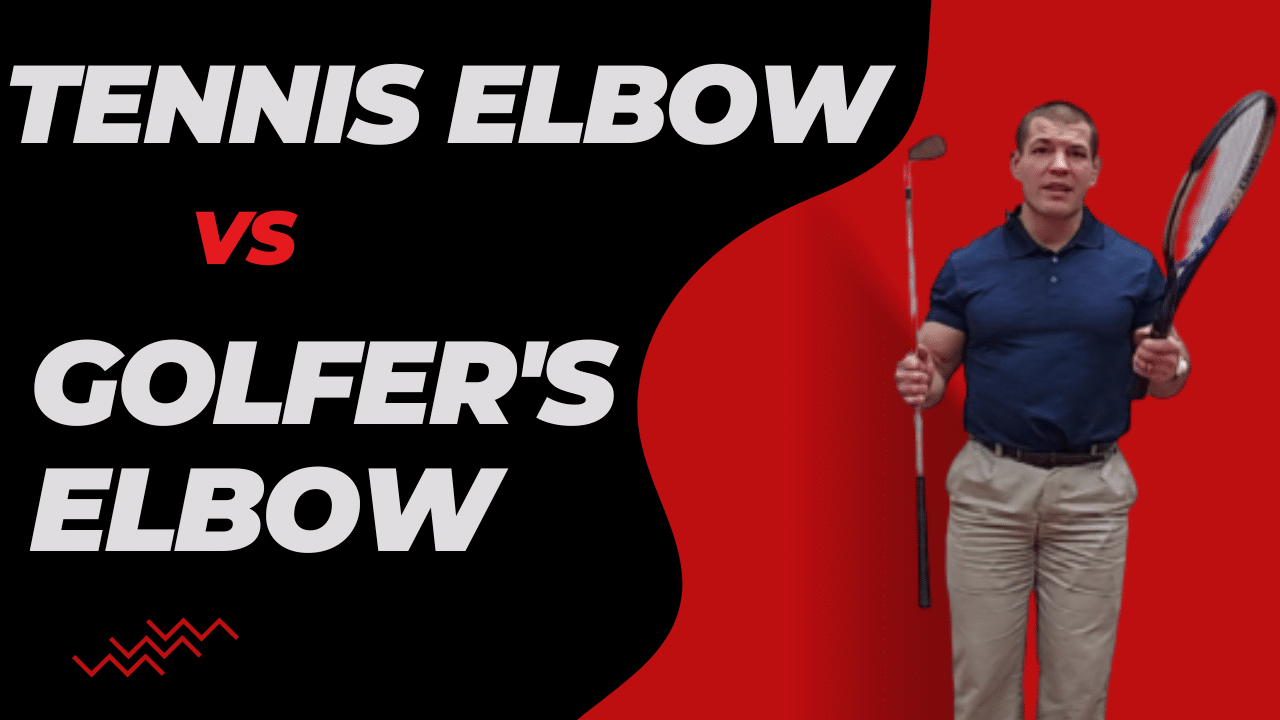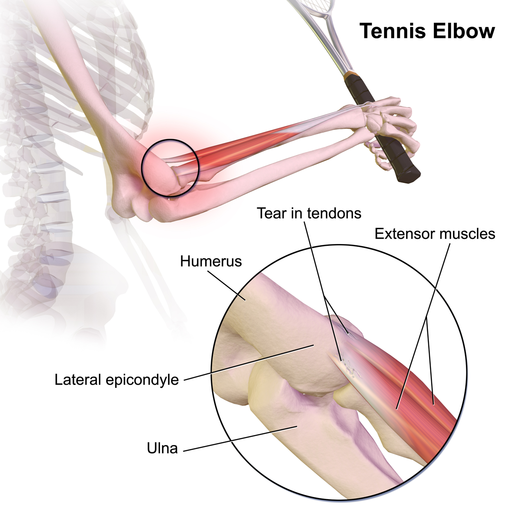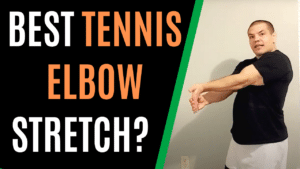What's The Difference Between Tennis Elbow vs Golfer's Elbow?
Tennis elbow and golfer's elbow are really the same problem, just on different sides of the elbow. Watch the video to learn how to get back to playing tennis and golf without without tennis elbow or golfer's elbow.

What Are Tennis Elbow And Golfer's Elbow?
Tennis elbow and golfer's elbow are both tendinopathies that happen where the forearm muscles attach to the elbow. The difference between tennis elbow vs golfer's elbow is just where those tendons attach.
You don't have to play tennis to get tennis elbow, and you don't have to play golf to get golfer's elbow. In fact, tennis players can get golfer's elbow and golfer's can get tennis elbow.
Actually, about 90% of tennis elbow cases happen in people who don't play tennis or golf at all.
However, in this post, we're going to cover tip to help you play golf and tennis without tennis elbow or golfer's elbow.
What Is Tennis Elbow?
Dirst we're going to talk about tennis elbow which is pain on the outside of your elbow.
It's otherwise known as lateral epicondylitis meaning inflammation of the bone on the outside of the elbow.
However, since lateral epicondyle pain is usually not inflammatory, it's more properly referred to as lateral epicondylalgia, meaning pain on the outside of the elbow.
What Causes Tennis Elbow?
Most tennis elbow isn't caused by playing tennis.
However, when you ARE playing tennis, lateral epicondyle pain often comes from one of two things:
- Hitting a backhand
- Hitting a top-spin forehand or serve
Tennis Elbow From Hitting A Backhand
The impact force of hitting a backhand when the ball hits your racket. You not only have to keep it from flexing your wrist, but you have to stop it, reverse the direction, and hit it back over the net.
So you get the compound force of ball coming one way, as well as trying to reverse the direction.
It's like hitting a car in a head-on collision vs. just a rear-end accident.
This combined force causes a lot of vibration through the strings of the racket. That vibration is then transmitted through your wrist extensor muscles attach and eventually on to the lateral epicondyle of the elbow.
Hitting a Top Spin Forehand or Serve
When you hit a forehand or serve with top spin, you have to flex your wrist and pronate your foream in order to creat the top spin.
This motion rapidly stretches the extensor-supinator muscles that attach to the lateral epicondyle of the elbow.
While this was once thought to be a major mechanism of tennis elbow, most tennis players will report having tennis elbow more commonly when hitting a backhand.
How Do You Hit A Backhand Without Getting Tennis Elbow?
A lot of the problem whether you're hitting a forehand or a backhand comes before you actually make contact with the ball.
You have to have your feet in the right place and be positioned well for your shot.
If you're reaching for your shot, then you're going to have to use more arm force to hit the ball.
That results in absorbing a lot of the vibration produced by the ball with your forearm.
Instead, if you can position yourself correctly before you hit your shot, you can use your body to create force.
You should start to create the force with your hips and your trunk, then your shoulders, and then finally if, you're going to put any spin on the ball, then your forearm and hand come in at the end.
Additionally, if you're just blocking the ball when you hit a backhand, you get all the force absorbed through your wrist extensors and elbow.
However if you start swinging before you make contact and then follow through the ball with your body, you'll be able to distribute the force of the ball better.
Additionally, having the right equipment can help prevent tennis elbow.
Using a light, flexible racket with a large head will help absorb some of the shock from the impact of the ball. One example of such a racket is the YONEX EZONE 100.
Additionally, using a dampener in the strings of a racket can help.
Finally, using a shock-absorbing brace can help.
Most tennis elbow braces are worn by the elbow, so by the time the vibration force has reached the brace, it's basically already at the elbow.
However, wearing a shock-absorbing brace around the wrist such as the TENEX Elbow Shock Absorber can help dampen the vibration force before it's transmitted through the wrist extensors to the elbow.
Now what about for golfer's elbow?
What Is Golfer's Elbow?
Golfer's elbow is pain on the inside of the elbow, or medial epicondylegia. Golfer's elbow is also commonly called medial epicondylitis, but that's only really true if it's inflamed, which most of the time it isn't.
Much like tennis elbow, you don't have to play golf to get golfer's elbow.
However, if you do golf, you'll be more likely to get it in your trail arm because you're using the flexor pronator group in your forearm when you're following through. This is particularly true if you're trying to create a lot of clubhead speed.
Interestingly, golfers often get tennis elbow on their lead arm. At the same time that you're using the wrist flexors of your trail arm, you're also using the wrist extensors of your lead arm, kind of like hitting a backhand.
How Do You Stop Golfer's Elbow?
A lot of the tips are very similar to the way that you stop tennis elbow.
Now obviously you're not running up to the ball, but getting in the right position and lining up your shot before you start your golf swing is still important.
If you turn your front foot forward a few degrees, that allows you to follow through your shot more after you hit the ball.
The next point is winding up appropriately in your back swing. You want to make sure you wind your body tight like a spring. That way, when you're unwinding that you've already got a lot of momentum built up before you impact the ball, and you don't have to create as much speed with your arms and your wrists. If you're trying to hit exclusively with your shoulders, forearms, and wrists, that's going to transmit a lot more force to your elbow and put you at risk for both tennis elbow and golfer's elbow.
What Kind Of Golf Clubs Are Good For Golfer's Elbow?
Much like with tennis rackets, using the right equipment can help lower the impact force with golfer's elbow.
Using golf clubs with graphite shafts can help both tennis elbow and golfer's elbow in golfers.
Precise M5 Men’s Golf Set – Driver, Wood...
$294.99 (as of January 15, 2026 19:27 GMT -06:00 - More infoProduct prices and availability are accurate as of the date/time indicated and are subject to change. Any price and availability information displayed on [relevant Amazon Site(s), as applicable] at the time of purchase will apply to the purchase of this product.)Many people think the graphite material absorbs shock better, and this may be true to some extent.
However, the real benefit of a club with a graphite shaft bends during your swing to store energy, kind of like winding up a spring. Then at impact with the ball, the shaft releases some of that stored energy to increase the club head speed at impact without requiring as much manual effort from your wrists.
Therefore, you don't have to swing as hard in order to hit the ball the same distance.
Having the right equipment can help both tennis elbow and golfer's elbow, but it's rarely a cure all.
Exercises For Tennis Elbow And Golfer's Elbow
One of the most common exercises for tennis elbow and golfer's elbow is to try to stretch the sore muscle. However, that's not always the best idea.
If you get tennis elbow from high-velocity sports like tennis or golf, you get a lot of eccentric loading on your wrist extensors.
What that means is that the muscle is contracting (trying to shorten) at the same time that it's lengthening.
That in turn creates micro-tears within the muscle and/or tendon.
If the tendon is already torn and you're trying to stretch it, that can potentially cause further tearing.
You probably don't want to do that.
Instead, you want to recondition the tendon by doing low-load, high-repetition exercises. It's basically aerobic exercise for your forearm muscles.
For tennis elbow, high repetitions of wrist extension exercises with no weight or very little weight.
For golfer's elbow, it's just the opposite. You want to do muscle low-load, high-repetition wrist flexion exercises.
Tennis Ball Massage For Tennis Elbow
Even though certain parts of the forearm muscles may be overstretched, there may be other areas of the muscle that are too stiff.
Muscles are made up of contractile units called sarocmeres that are lined up end to end to end.
So it's possible for some sarcomeres to be overstretched while others are too stiff.
Using a tennis ball or a golf ball and rolling it around on the parts of the muscle that aren't sore that but may have knots is a good way to help get release the areas of the muscle that are too stiff. This is similar to a physical therapy treatment called manual trigger point therapy.
If that doesn't work there are additional treatment options such as dry needling that can help release those muscle knots or trigger points faster.
Sometime Stretching Exercises Can Help
There's rarely an always or never for any type of problem. There are cases where stretching can help tennis elbow and golfer's elbow. Often stretching the muscles on the opposite side of the forearm can be helpful.
For example, if the wrist extensors are sore, stretch the wrist flexors. If the wrist flexors are sore, stretch the wrist extensors.
I've got more about stretches for tennis elbow in this post.
Conclusion
In conclusion, tennis elbow and golfer's elbow are both elbow tendinopathies. The differences between tennis elbow vs golfer's elbow are just where the tendon attaches and what movements of the wrist cause them.
If you do play tennis or golf, treating tennis elbow or golfer's elbow requires a combination of using the correct technique during your swing, the right equipment, and an appropriate exercise routine.
Seeing a physical therapist who has experience treating tennis elbow is advisable to help point you in the right direction so that you can get back to playing your best as quickly as possible.
Need Help For Tennis Elbow Or Golfer's Eblow?
Click the button below to get a Free Consultation with one of our specialist physical therapists








